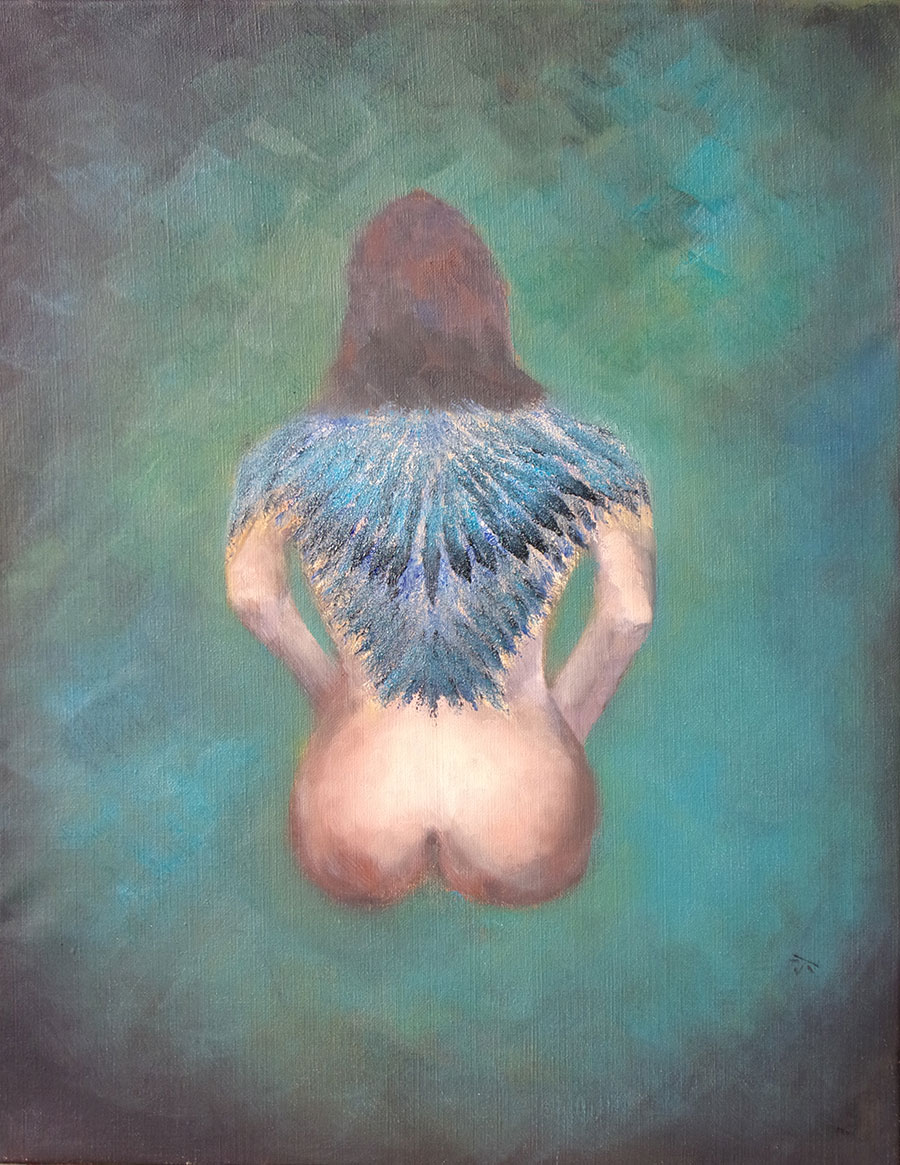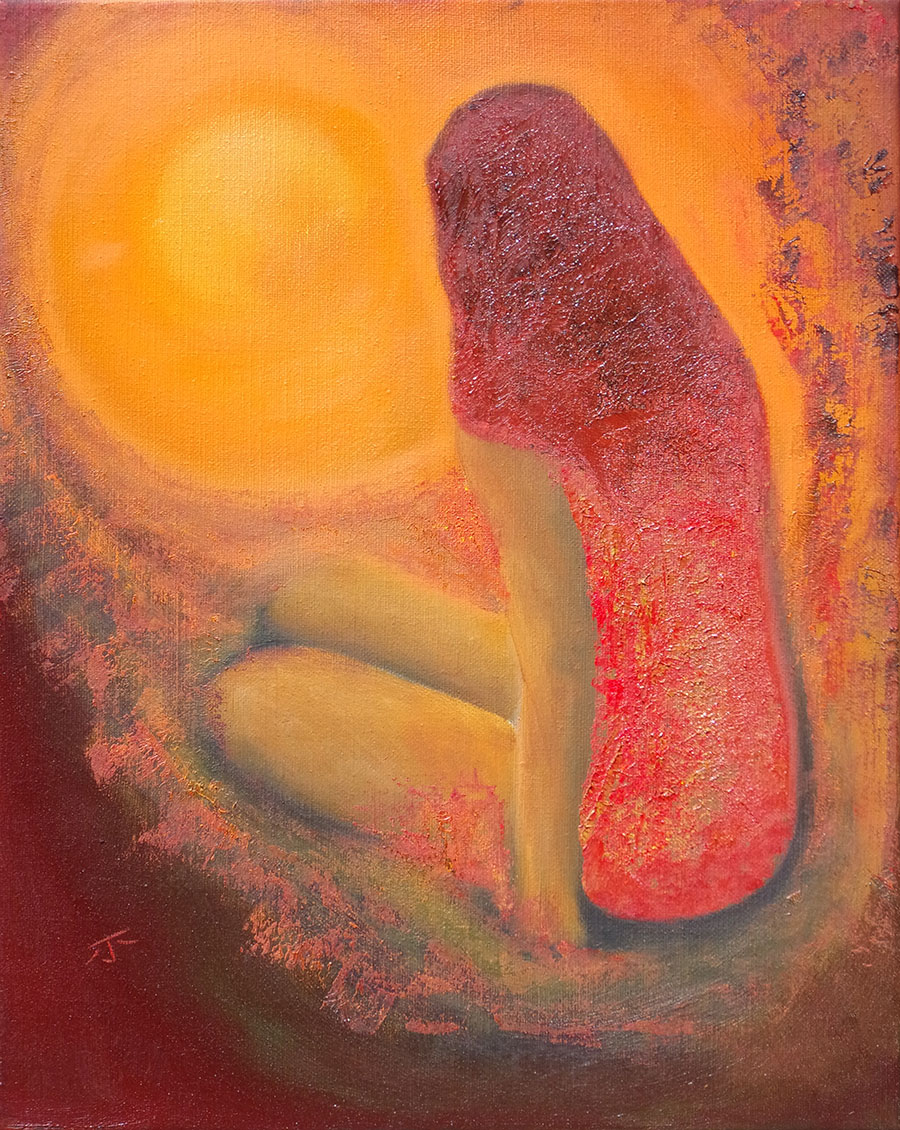Tarot Series
Influences:
Man Ray’s Surrealist photograph Ingres’s Violin (1924)
The World Tarot Card
Theme Tune: Fleetwood Mac’s Rhiannon (1975)
Wings
Autumn 2022. Oil on Canvas. 55 x 70cm
The Sheltering Sky
Alone she stood there in the mist,
outlined against the sky.
Before her reared the abyss
entreating her to fly.
Above her shone the jewelled stars,
in the lapis sheltering sky.
She listened for the silences
and asked the question why?
About her lay the darkness
as she leaned toward it now.
The velvet blackness beckoned.
She asked the question how?
Awakened by the beating
of a heart filled full of light,
on iridescent feathers
she jumped into the bright.
Magical Flight In Theory And In Practice
Shamanism by Mircea Eliade (1964).
“A number of myths refer to a primordial time when all human beings could ascend to heaven, by climbing a mountain, a tree, or a ladder, or flying by their own power, or being carried by birds. The degeneration of humanity henceforth forbids the mass of mankind to fly to heaven; only death restores men (and not all of them) to their primordial condition; only then can they ascend to heaven…..”
The Yoga Sutras of Patanjali, Mystic Powers III:42 describes how through intense concentration one can acquire the ability to travel through the sky.
The Star Card
2022. Oil on Canvas. 70 x 90cm
The Star Card, Surrealism and Andre Breton
Arcanum 17 by André Breton (translated by Zack Rogow 2004).
“A much brighter star is inscribed in the septenary… and it is the Dog star or Sirius, and it’s Lucifer light bearer and it is, in its glory surpassing all the others, the Morning Star….. a young woman is revealed, nude, kneeling by the side of a pond, and with her right hand she spills into the pond the contents of a golden urn, while her left hand empties onto the earth an equally inexhaustible silver urn. Alongside that woman who, beyond Melusina is Eve and now is all womankind, the leaves of an acacia rustle to the right while to the left a butterfly flutters on a bloom.”
Victor Brauner, Kabbalah and the Tarot
The Magician Triumphant: Occultism and Political Resistance in Victor Brauner’s Le Surréaliste 1947: article by Daniel Zamani (in Abraxas Special Issue No 1 2013).
Unable to obtain a visa for the USA or Mexico, Brauner spent the war years in hiding and began an intense study of the Jewish Kabbalistic tradition. His depiction of the Magician card — Le Surréaliste — was displayed in the 1947 Surrealist exhibition and is now in the Peggy Guggenheim collection in Venice. Brauner’s depiction of the Magician shows the first letter of the Jewish alphabet — Aleph — in his hat just above the lemniscate.
The Kabbalah in Theory and Practice
The Kabbalah is a Jewish mystical tradition. By the time of Cornelius Agrippa’s three books on occult philosophy in the 16th Century, it provided a filing cabinet of occult correspondences for the western mystery tradition.
Tarot and The Kabbalah
Eliphas Lévi was a 19th century French occultist and writer on various aspects of Magic. Sometime in late 1852 Lévi met a Polish emigré called Wronski. According to Lévi’s biographer Chacornac, (1926), Wronski taught Lévi the Kabbalah.
Some time later, in a flash of inspiration, Lévi concluded that the 22 Kabbalistic paths which are accessed by the 22 letters of the Jewish alphabet corresponded to the 22 Major Arcana of the Tarot pack.
Transcendental Magic by Eliphas Lévi (translated by A E Waite 1896).
“Without the tarot the magic of the ancients is a closed book, and it is impossible to penetrate any of the great mysteries of the Kabalah.
Waite’s footnote says: “There is a sense in which this statement represents the main thesis of Levi respecting the secret tradition in Israel. It must be taken therefore as his serious and considered view, but its sole foundation is that there are 22 Hebrew letters and 22 major arcana. They belong to one another as much and as little as the 22 chapters of the Apocalypse connect with either.”
Tarot trumps could be used as illuminating doors of perception. Stained glass windows for the soul.
This system of correspondences was adopted by the Golden Dawn and influenced the Rider-Waite and Thoth tarot packs.
Lévi also influenced French esoteric circles, through Oswald Wirth and Papus.
Oswald Wirth’s book on the Tarot, originally published in Paris in 1927, equates the Magician tarot card with the first letter of the Jewish alphabet, Aleph.
Leonora Carrington and the Tarot
The Tarot of Leonora Carrington, edited by Susan Aberth and Tere Arcq (2023).
“The Tarot is not meant solely for divination purposes. Each suggest navigation devices where a poetics of the unconscious is available for immediate exploration. These cards may be consulted as subliminal objects…they give access to magical environments. Because the subliminal body might be conceived as an out-of-the-body experience it also entails a liberation from the rational corporeal form. This body is able to travel through unconscious domains. Ultimately it is endowed with a projective capacity that enables an exploration of the visionary world.” (from the Introduction by Gabriel Weisz Carrington).
“While in Paris Carrington wanted to study Jewish mysticism, but discovered this path was unavailable to her as a woman and so she turned to (Dion) Fortune’s The Mystical Qabalah…Later on, in Mexico, Carrington found this book in Varo’s library and they studied it together.“
Ithell Colquhoun and the Tarot
Ithell Colquhoun, Genius of the Fern Loved Gully by Amy Hale (2020).
In 1977 Ithell produced her own set of Tarot cards which were published by Fulgur Press (2020).
“Colquhoun’s Taro deck (her preferred spelling) was created in prototype from enamel on paper and exhibited only once in her lifetime. Running from July 26- August 13 1977, the exhibition was accompanied by a short essay The Taro as Colour. …..this deck was designed for use in meditation and contemplation, not divination.”
Strength
Spring 2023. Oil on canvas. 40 x 50cm
Theme Tune.: Lily, track from Kate Bush’s album The Red Shoes (1993).
Surrealism and Magic
The Esoteric Secrets of Surrealism by Patrick Lepetit (2014) quotes Michel Löwy: “Sparks flying from the different forms of magic could set fire the powder and thereby help Surrealism in its eminently subversive enterprise of poetically re-enchanting the world.”
Whilst magic and the science of names attracted the surrealists it was not because they wanted to control the forces of nature by these methods. They wanted to change life.
Magic In Theory And In Practice
Dion Fortune’s definition of Magic: “The art and science of causing change in consciousness in accordance with will.”



